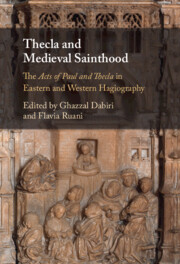Afterword
Thecla and the Power of an Open Story
Published online by Cambridge University Press: 06 May 2022
Summary
Perhaps more than most ancient traditions, Thecla’s has been characterized by controversy, and yet little attention has been paid to the positive value of indeterminacy in the Thecla tradition. After offering an overview of approaches to the Acts of Paul and Thecla and related texts over the last half-century, we ask how the open qualities of Thecla as a protagonist may have enhanced her tradition’s ability to serve as the basis for successive re-imaginings. We conclude by suggesting that as ‘an ambiguous heroine in an unstable story’ Thecla exemplifies the value of indeterminacy and instability in hagiography.
- Type
- Chapter
- Information
- Thecla and Medieval Sainthood<I>The Acts of Paul and Thecla</I> in Eastern and Western Hagiography, pp. 318 - 328Publisher: Cambridge University PressPrint publication year: 2022

